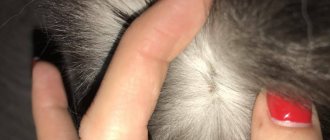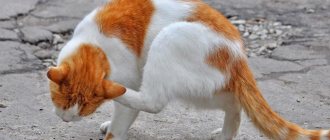Lice are also carriers of helminth eggs. As a result of this, helminthiasis and general exhaustion are added to the skin lesions of the infected animal. Lice spend most of their time attached with their paws to the base of an infested cat's hair. They feed on the epidermis, secretions of the sebaceous glands and blood.
Female lice lay eggs called nits. During her life, the female parasite lays 20-60 eggs and fixes them to the root part of the hair. After 7-12 days, the eggs hatch into larvae that look similar to adults, which after three molts turn into mature insects.
What to do in such a situation? To get started, we recommend reading this article. This article describes in detail methods of controlling parasites. We also recommend that you consult a specialist. Read the article >>>
In large quantities, cat lice accumulate on the head, neck and at the base of the tail. These parasites infect pets of all breeds, except hairless cats. They are most often found in animals with long and thick hair.
More about cat lice
Sedentary parasites that live in the fur of cats are usually called lice eaters. They, unlike their counterparts, extremely rarely feed on blood, specializing in the upper exfoliating layers of skin and fur. Only in rare cases do cat lice feed on blood on wounds and abrasions. Lice eaters are not capable of biting a pet and sucking its blood, as lice do on humans.
Methods of infection
Unlike a flea, a louse can begin to parasitize a cat at any time of the year. The routes of invasion are different:
- Contact with a sick animal. Kittens are at risk, since the lice eater can easily switch to it from the mother cat. Self-walking cats, which often interact with stray animals, are also more susceptible to this disease than others.
- Through care products or bedding. Eggs or larvae may remain on the comb or in the cat's house.
- The appearance of an infected rodent in the house.
In general, cats that do not receive good nutrition and are kept in conditions of high humidity are more susceptible to lice bites.
Symptoms
A disease in which cats have lice is commonly called trichodectosis. At an early stage of the lesion, it is quite difficult to identify it, but we will present the most obvious symptoms:
- Itching - its intensity only increases every day, causing great discomfort to the animal. Watch your cat: lice infestation will make him restless and irritable.
- Sudden shedding has nothing to do with natural factors or seasonality. Clumps of fur fall out only in some places, forming bald spots.
- Nits - when you look closely at the fur and skin of an animal, you can easily see not only the parasites, but also the rich black color of the larvae.
- Redness and wounds - given that cat lice feed on the skin, wounds and abrasions appear quite quickly at the site of the lesion, which are simply impossible not to notice.
On light coats the described symptoms are more obvious. If you did not notice them at an early stage, and the disease acquired a jet form, the pet may be left without hair.
Common fleas
To most people, they are tiny amber-colored creatures capable of setting world records for high jumps and driving pets and their owners crazy. In fact, these are real bloodsuckers and carriers of serious infections.
Scientists believe that fleas originated from flying insects about ten million years ago. Those individuals that, while living on the body of their “master”, lost their wings turned out to be more tenacious. Therefore, the winglessness of fleas today is explained by their parasitic lifestyle. The body structure of fleas is adapted to movement in the fur of the “host” animal - it is strongly compressed from the sides and is so strong that it can withstand the claws of animals. You need to have great skill to crack its “shell.” The transition from one host to another is easily accomplished by active crawling when meeting host animals or by jumping in their permanent habitat, since the hind legs of fleas are jumping. In order to jump on a passing dog or cat, a flea must move with an acceleration 140 times greater than the acceleration of Earth's gravity (9.8 m/s). (For reference: a person’s bones begin to break even at twenty times acceleration.) Such jumping ability is ensured by the content of resilin in their body, a special protein substance.
Fleas on dogs. A specialist can determine at first glance who the potential victim of a particular individual is. Fleas can exist and reproduce normally on animals suitable for them.
Fleas pose a great danger as carriers of human and animal diseases, such as plague, which affects rodents, camels and other animal species, as well as typhus, tularemia, and rickettsiosis; fleas are intermediate hosts of the causative agent of dipylidia in dogs, cats and humans.
Humans are parasitized by the human flea (Pulex irritans), which can also live on dogs, cats and even horses, that is, animals that have constant contact with humans. Nowadays, if a person complains of flea bites, then most likely the troublemaker is a cat flea (Ctenocephalus telis), which, in addition to cats, can live on dogs and hedgehogs. The cat flea is quite happy with modern conditions, and even in our relatively hygienic homes it feels just fine.
Fleas on dogs. Dogs are parasitized by the dog flea (Ctenocephalus canis). Parasites are transmitted to puppies from their mothers. Fleas on dogs are more common under unsatisfactory conditions and poor nutrition. Fleas, being hematophagous, pierce the skin when sucking blood and inject saliva, which has toxic properties. Flea bites cause itching. Scratching leads to the development of dermatitis. Young dogs are affected more intensely and have a harder time enduring the infection. Fleas are easy to detect when examining the outer coverings of dogs.
Until now, entomological scientists are racking their brains over the question of how to get rid of fleas that plague domestic animals and humans. Any apartment in which an animal is born is a haven for fleas. In order to get rid of them, you need to understand their life cycle.
How do fleas appear on a domestic dog?
Fleas can even live on a clean, well-groomed pet dog. Insects jump beautifully. From the starting point to the destination can be more than 30 cm in length and height. For this reason, a pet can become infected in a variety of situations. Most often, the appearance of parasites is observed after:
- forest walks. Many fleas live in rodent burrows;
- visits to places of mass walking. Infected pets often shake off their eggs into the grass, foliage, or asphalt, from where the larvae easily stick to their fur;
- contact with other animals. The main carriers are dogs, cats, rats. Even with simple sniffing and close proximity, relocation of pests can occur. In the case of joint games, the risk is several times higher;
- contact with a person. Fleas love to move on people's clothes. In addition, eggs often stick to pants and shoes;
- visit to an infected house. If a flea gets into the house on an animal or person, it will successfully reproduce in furniture and fleecy carpets. From there, the bloodsuckers will certainly jump on all the guests in search of food.
What do cat lice look like?
If you want to recognize cat lice, you need to know what they look like. Outwardly, these are rather small parasites, their body is elongated, but quite dense. On the triangular head there is a special recess for capturing hair. Lice are easy to distinguish by their light yellow color and sedentary lifestyle - they will never jump, like fleas.
A distinctive feature of lice eaters is their powerful jaws, which allows them to easily grab and bite off pieces of skin and fur. This is what causes severe itching in pets.
Diagnostics
You can also detect the parasite at home. It is enough just to examine the cat. If you part the fur, you can see the eggs of the pest; they have a darker color. But it is much more difficult to notice them themselves: since they are almost transparent and have an imperceptible color. Therefore, it is recommended to use a magnifying glass. It is better to search in sunlight.
Ordinary adhesive tape can help in the search.
It is enough to glue it to the parting of the fur. Both eggs and adult parasites can stick to the tape. Interesting: you can distinguish lice and fleas by the fact that the latter can bite humans.
You can also suspect parasites in your pet if there are characteristic signs, for example, crowded fur, loss of elasticity and shine, as well as dandruff.
The cat louse is a heat-loving insect. Therefore, you can do this trick: place your pet for a short time under a heating element in the house, for example, place it near a radiator. After some time, about 15 minutes, the pests will come to the surface of the wool themselves. Then they will be noticeable.
Don't rush to make a diagnosis yourself. It is imperative to show the animal to a specialist. He will be able to accurately determine the type of parasite and prescribe the correct treatment.
Why are they dangerous?
Lice on cats are a source of discomfort and irritation, physical inconvenience, accompanied by intense itching. The result is wounds and abrasions on the cat’s skin. Severe infection provokes excessive hair loss and baldness; it is quite difficult to stop this process. The main consequence of parasitism by cat lice is dermatitis of various types, as well as pediculosis.
Rules for removing lice from cats
If an animal has cat lice, antiparasitic treatment must be carried out following certain rules. First of all, it is important to exclude the possibility of contact of the animal with a toxic substance. To do this, you can put a special restrictive collar around the cat's neck. Otherwise, the necessary actions are prescribed in the instructions for the selected drug.
It is important to remember that some insecticides do not have a detrimental effect on parasite eggs, which are protected by a dense capsule.
Accordingly, to prevent the reappearance of insects, it is necessary to carry out additional treatment of the cat two weeks after the first procedure.
Treatment
Therapeutic procedures include the destruction of lice and elimination of signs of dermatitis in cats. Possible complications include helminthiasis and allergic manifestations.
Insecticides are used against lice in the form of emulsoids, drop mixtures, sprays and collars impregnated with repellent. Shampoos are used to get rid of Felicola subrostratus from weakened animals and kittens. They cleanse the cat of lice, but do not prevent a new infestation.
Emulsoids
The active ingredients of insecticides are wax-like substances. Organic solvents form an essence that can be mixed with water. For example, 1 ml of insecticide working solution is mixed with 1 liter of water. Vestrumite is applied to the fur, the mixture settles on the skin, the eluent evaporates, and the active component in the form of a droplet of a wax-like substance interacts with the lipid complexes of the skin. The insect dies when it comes into contact with the poison. The toxin is not absorbed into the blood, so it is safe for cats. For some time (1-2 weeks), the active compound remains toxic to insects, gradually being washed away by the secretion of the sebaceous glands.
Such preparations are extremely cheap and are produced in sealed ampoules, which prevent premature evaporation of the solvent, but their inconvenience is as follows:
- Short period of protection.
- The working solution is unstable and must be used on the day of preparation.
- The drug is toxic if it comes into contact with the wound or the eye.
- The flow of the working solution onto the mucous membranes of the cat is less dangerous than into the blood, but can cause mild poisoning, characterized by the appearance of foamy discharge from the mouth and nervous symptoms.
Therefore, the cat must be dried under a hair dryer or allowed to dry, preventing the licking of the toxic liquid by wearing a restrictive collar.
In addition, treatment with emulsoids must be duplicated no later than two weeks. This is due to the fact that the eggs are protected from the action of the poison. In order for an insect to be poisoned, it must hatch from the egg, and by that time the drug will have expired. To prevent the parasite from reaching sexual maturity and laying eggs, a new portion of insecticide is required. In demand: diazinon, neostomazan, butox.
Drops and sprays
Drip mixtures do not have the disadvantages of emulsoids. They are applied to the withers or distributed along the back. The contents are absorbed by the sebaceous glands, and then, within a month, are released onto the surface of the skin. The destruction of parasites begins a day after application of the drug. The larvae manage to hatch from the eggs before the insecticide expires and die. The disadvantage is the comparative high cost.
Drops in demand: Stronggold, Bars, Frontline, Advantage, Hartz.
Sprays are nothing more than emulsoids that contain additional components. Therefore, the precautions for their use are the same as for emulsoids. The advantages include the absence of the need for immediate use of an aerosol. With proper use, the container with insecticide will last for many months. The disadvantage is the high cost. The drugs from the same manufacturers as the drops are in demand.
Collars and shampoos
Safety neck rings are impregnated with insecticide and provide long-term, up to six months, protection against insects. The action does not begin immediately; before putting on the collar, the lice are exterminated with emulsoids.
The main disadvantage is the allergenic effect on the cat of individual components of the accessory. Therefore, the use of collars for kittens younger than six months is not recommended. They should not be placed on a lactating animal to avoid poisoning the ubiquitous kittens. Collars from companies producing drops and aerosols of the same name are in demand.
Shampoos do not contain toxic substances - only repellents. They are suitable for treating small kittens. After bathing the cat, wash off the shampoo. Lice and fleas scatter. Disadvantage: no prolonged protection. Driven out today, insects can successfully resume their attack on the cat tomorrow.
Treatment of dermatitis
Therapeutic procedures to eliminate concomitant pathologies are aimed at stopping skin inflammation. The severity of the lesion dictates the use of the following groups of drugs:
- Anti-inflammatory.
- Antiseptic.
- Antimycotic.
- Wound healing.
The vast majority of dermatitis of parasitic etiology develops in the same way. Initially, the skin is exposed to mechanical and allergic irritation. Then the inflammatory process is complicated by the addition of fungi and bacteria.
The following funds are in demand:
- Migstim. Anti-inflammatory spray.
- Vedinol. Antiseptic ointment.
- Anandin. Anti-inflammatory ointment.
- Zooderm. Antiphlogistic liquid.
- Epacid-F Antimycotic drug.
- Terramycin spray. Antiseptic.
- Stop Itching Spray.
General recommendations
You can cure your pet of parasites, but you cannot protect against new ones. You can remove these creatures from the apartment, but your baby’s “friends” may also have fleas. Your apartment is also not protected from the appearance of fleas from the basement or from your neighbors. In general, outside the apartment they can be anywhere.
Inspect your pet more often, especially the tummy, as it is easy to spot such pests there.
You can get rid of these parasites. All you have to do is go to a pet store. Domestic manufacturers have developed many special flea shampoos . But you shouldn’t so carelessly believe everything that’s written on the label. In addition, your baby can also be poisoned by this shampoo when he washes his fur. Better caress the fur of your beloved pet.
There are special drops that are very effective in removing fleas. You need to drop a few drops in a place inaccessible to your pet (for example, at the withers). These drops have one peculiarity: they very quickly penetrate the blood and poison it for parasites. All deposited larvae also die. The action of the drops lasts for a very long time. But after applying the drops, the animal needs to be washed a few hours later.
The safest of all means are special flea collars. They are impregnated with some composition of chemical elements. But not all elements are beneficial for animals; allergies may occur.
You can also find anti-parasite spray in the pet store. It is as effective as drops. It will rid your pet of fleas and protect at some distance.
The apartment needs thorough cleaning with special cleaning products. Fleas may reappear in your home, but the product you treat your pet with will protect him for a while.
Prevention
Regular inspection and treatment with anti-parasite products will protect your cat from lice, ticks, and fleas. Using a special collar will also help. To select the size, measure the diameter of the cat's neck. The collar is selected so that it fits tightly on the animal without causing discomfort.
If it is too loose, the cat will cling to various objects with it during street walks. This will increase the risk of injury.
A tight collar puts pressure on the animal's neck. The cat tries to remove it and may injure itself.
The collars are impregnated with special components that not only repel lice, fleas or ticks, but also kill existing parasites. They can also be used as a method of treatment.
The active components of the collar have a limited lifespan. Usually it ranges from six months to eight months. Don't forget to change your protective equipment on time.
If you use the services of cat groomers, choose your groomer carefully. Feel free to ask how he handles the tools. It is advisable that they be disinfected in front of you. This will protect your pet not only from lice, but also from some cat infections.
Used brushes, slicker brushes, combs, and cat bedding received as a gift must be disinfected. Wash them with a special product, wash the textiles at high temperature.
Lice cause a lot of problems for both the animal and its owner. Therefore, you should not neglect the seasonal processing of the animal. And the best protection against uninvited “guests” will be anti-parasite collars.
Which drugs to choose
The market for veterinary drugs is saturated with drugs against cat lice. You can choose based on price, manufacturer, shape, composition. Products based on cypermethrin and permethrin are effective. You can buy, for example, Ectometrin from Medilis. Ectometrin is an insectoacaricidal (antiparasitic) agent intended to combat lice, fleas, lice eaters, lice beetles, skin beetles, flies, sarcoptic, ixodid, and chicken mites parasitic on animals (dogs, cats, fur-bearing animals, cattle, pigs, horses, goats , sheep) and poultry (chickens, geese, ducks), as well as for disinsection and decontamination of livestock buildings. The main thing when choosing and using any product is to strictly adhere to the instructions. And on the website you can always use the Ectometrin “working solution” calculator.
It is possible to defeat parasites!
Antiparasitic Complex® - Reliable and safe removal of parasites in 21 days!
- The composition includes only natural ingredients;
- Does not cause side effects;
- Absolutely safe;
- Protects the liver, heart, lungs, stomach, skin from parasites;
- Removes waste products of parasites from the body.
- Effectively destroys most types of helminths in 21 days.
There is now a preferential program for free packaging. Read expert opinion.
Read further:
Deworming drops for cats: list of the best drugs, how to use, price and reviews
Advocate against worms and fleas for cats and dogs: instructions for use, price, reviews
No to ticks: where to order insect repellent treatment?
What do lice eat on the human body, the lifestyle of parasites
Long worms in cats: main types, description and methods of treating parasites in cats
Vetom 1 for cats: instructions on how to give the drug to a cat, reviews and description










